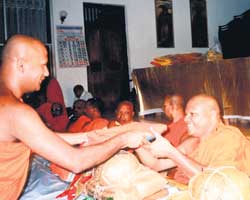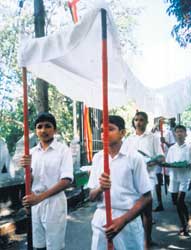
| Vassana has ended Udumbara Udugama looks at the significance of the Katina Pinkama recently concluded at the Malwatte Maha Viharaya During the time of the Buddha in India, it was permitted for the Sangha to spend the rainy season (vassana) in one place, as it was impossible to journey forth due to the rains. It was believed that with the rains, tiny insects came out of the earth and when the Theras walked, these insects were trampled and killed. Some people criticized this. Hence, the Theras stayed in one place during this season. This practice is continued even today in Sri Lanka and Buddhist monks live indoors for three months during the rains. This is termed 'Vas Vasanawa’. The dayakas (lay devotees in the village) offer a sheaf of betel and invite the theras to spend the 'Vas' season in their village viharaya. Only 'Upasampada' (higher ordination) Theras can observe the Vas season in this manner.
This year, the Vassana season began with the Esala Full Moon Poya in July and ended with the Vap full moon Poya on October 6. Thereafter, the 'Katina Cheevara' month began. After the three months of 'Vas' is over, a 'Katina Cheevara’ (a robe) is presented to a Thera who has observed the 'Vas' period of three months continuously. Even though there are many Theras in the viharaya, only one 'Katina Cheevara' is presented. The Katina Cheevara Pooja ends with the Il Poya which falls today, November 5. The Malwatte Maha Viharaya in Kandy concluded the vassana season with the 'Katina Cheevara Pinkama' on October 22. Ven. Udugama Somawansa Thera explained that the custom is for a dayaka to invite the thera to be in the viharaya for three months. The thera then has to say a 'vakya' {sentence) "Imasmin vihare imanthe masan the masan vassang upemi ida vassang upemi", three times and agree to stay there. Ven Aluthgama Dhammananda Maha Thera of the Malwatte Viharaya who conducted the 'Katina Cheevara Pinkama' this year said that all the 'Upasampada' Theras of the Malwatte Viharaya have to stay in the viharaya during the Vas season. The practice here is for a gong to be sounded on the Poya day and all the Theras have to assemble at the 'Poyage' and after observing religious ceremonies begin their vas season of three months.
On the day of the Katina Pinkama, a white cloth is brought in a perahera (procession) with dancers, drummers, flag bearers etc. by the dayakas at dawn to the viharaya and they request the thera to make a robe. This is then cut into five sections and stitched again into a robe. It is said that the stitching is done in the formation of a paddy field with 'Niyaras'. The significance of this is that no one will want to possess a patchwork cloth and so it will not be stolen. It also gets rid of 'thanha' (craving). The Ven. Thera stated that in the past years Ven. Udugama Somawansa Thera stitched the robes, but this year it was done by a layman. As there are three viharas in the Malwatte - the Poyamalu Viharaya, the Malwatte Maha Viharaya and the Nila Aramaya, three Katina Cheevara are prepared for each of these. These three white cloths are taken under a 'Uduviyana'
(canopy) in a procession to the well near the Kandy Lake, washed
separately and brought back to the viharaya. During the Buddha's
time in India, the Katina Cheevara were prepared with cloth taken
from rubbish heaps - cloth that was used to wrap corpses. Therefore,
they had to be washed and cleaned. This is the practice and custom
that is followed today by washing the Katina Cheevara cloth, said
Ven. Dimbulkumbure Wimaladhamma Maha Thera There was a Dhamma Desana (sermon) by the Thera and a dana (alms giving} for about 48 Theras by the dayakas. The three robes were then presented to three Theras selected by all the other Theras who were present during the 'vas' season. The Theras receiving the Katina Cheevara have to recite a 'Vakya' and accept it. Only Upasampada Theras are permitted to be present at the presentation ceremony with the Samanera Theras (novices) requested to leave the hall. The significance of the Katina Cheevara Pinkama is that this ceremony is conducted only once a year. Another feature is the 'Kap Ruka' meaning the heavenly wish conferring tree. Generally it is a branch of a jak tree kept in the hall. Offerings made by the dayakas were placed on this, but now they are placed on a table. Items needed by the Theras such as robes, toothpaste, soap, razors, writing paper etc. are offered. During the Katina Pinkama, religious ceremonies are conducted at the viharaya by the dayakas by lighting pahanas (oil lamps, burning incense sticks, offering flowers and organizing Bodhi Pooja. Ven. Dimbulkumbure Wimaladhamma Thera explained that the Thera who receives the Katina Cheevara has five privileges: He does not have to inform anyone when he leaves the viharaya, he can possess any number of robes (whereas others have only a limited number), all the 'Sangeeka Pirikara' can be kept for himself (others must distribute) and he can request for 'Pirikara'. All Upasampada Bhikkhus have to wear the 'Thun Sivura' (three robes - Andanaya, Thanipata Sivura and Depata Sivura) but the Thera who receives the Katina Cheevara can wear the Andanaya and one other robe. Hoowever, these privileges are given only for five months after receiving the Katina Cheevara. The Thera further stated that the Katina Cheevara is marked with three dots placed in a corner of the robe. This is done by using a betel leaf which is placed on the robe and pressed and twisted with the finger to extract the juice and stain it. During the Katina month, the devotees perform 'Bodhi Pooja' and other religious ceremonies to gain merit. The Katina Cheevara is prepared and presented within twelve hours of that particular day. A Thera's seniority is judged by the number of 'Vas' seasons he has spent after 'Upasampada'. |
| || Front
Page | News
| Editorial
| Columns
| Sports
| Plus
| Financial
Times | International
| Mirror
| TV
Times | Funday
Times | Kandy
Times || |
| |
Copyright
2006 Wijeya
Newspapers Ltd.Colombo. Sri Lanka. |

